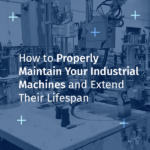Filling machines are at the core of many production processes across industries like food and beverage, cosmetics, and pharmaceuticals. These machines, essential for maintaining productivity and product quality, represent a significant investment for businesses. Therefore, ensuring their optimal performance and longevity is important.
In this article, we’ll discuss why regular maintenance is vital, the daily, monthly, and yearly tasks you should implement, and common problems to watch out for. We’ll also cover manufacturer recommendations to ensure your filling machines operate at their best.
Why regular maintenance is essential for Filling Machines
Proper maintenance of your filling machines isn’t just about avoiding costly breakdowns. It also helps to:
- Prolong Equipment Lifespan: With the right maintenance practices, a filling machine can last over 10 years without needing a major replacement.
- Maintain Productivity: Well-maintained equipment minimizes downtime, resulting in smoother production runs.
- Ensure Safety: Worn or poorly maintained parts can pose safety risks to operators.
- Reduce Repair Costs: According to a report by Packaging Digest, corrective maintenance (repairing a machine after a breakdown) can cost up to 50% more than regular preventive maintenance.
The goal of maintenance is to identify and address wear-and-tear signs before they become serious issues, allowing you to maximize your equipment’s lifespan while keeping production stable and efficient.
Daily maintenance tasks
- Regular Cleaning
Cleaning the machine after each production cycle is critical to prevent product residue buildup. Residue can damage mechanical components and compromise the quality of subsequent batches. In industries like food and pharmaceuticals, cleaning also prevents cross-contamination. Use cleaning solutions suited to the machine’s materials (stainless steel, rubber, etc.) to avoid surface damage.
- Lubrication of Moving Parts
Proper lubrication reduces friction and wear on moving parts, allowing the machine to operate smoothly. Bearings, chains, and seals should be lubricated as per the manufacturer’s recommendations. Always use the specified type of lubricant, as an incorrect oil or grease can cause premature failure.
- Visual Component Inspections
A quick inspection at the end of each production day helps detect early signs of wear. Look for loose bolts, worn belts, or cracked components. Addressing minor issues early prevents them from escalating into serious problems.
- Safety System Checks
Modern filling machines are equipped with safety features such as emergency stop buttons, protective sensors, and more. Regularly ensure that these systems are fully operational to guarantee the safety of operators and the entire process.
Monthly and yearly maintenance tasks
- Deep Cleaning
While daily cleaning is essential, a deep cleaning should be performed at least once a month. This involves disassembling certain machine parts, such as nozzles, conduits, and seals, to remove any accumulated residue. For machines used in chemical industries, this thorough cleaning helps prevent corrosion and ensures the chemical stability of contact materials.
- Replacing Wear Parts
Filling machines have several wear parts, including seals, belts, and nozzles. Depending on machine usage, these components should be replaced every 6 to 12 months. A defective seal, for instance, can cause product leaks, resulting in material loss and production interruptions.
- Sensor Calibration and Adjustment
Level, volume, or pressure sensors must be calibrated regularly to ensure maximum accuracy. Incorrect calibration can lead to dosing deviations, which is particularly problematic in food and pharmaceutical sectors, where precision is crucial for quality compliance.
- Component Alignment Check
Proper alignment is essential to prevent excessive vibrations, which can damage bearings and shorten the lifespan of critical parts. Misalignment can also lead to errors in the filling process.
Common problems and how to avoid them
- Product Leaks
Leaks are often caused by worn seals or loose connections. To prevent this, inspect and replace seals regularly and ensure all connections are secure.
- Nozzle Blockages
Filling nozzles can become clogged with product residue, especially when dealing with viscous liquids or particle-containing mixtures. Clean nozzles daily, and if necessary, use specialized nozzles designed for your product type.
- Belt Wear
Worn belts can lead to slippage or movement interruptions. Check belt tension and replace them as soon as signs of wear appear.
- Pressure Variations in Pipelines
If pressure in the pipelines fluctuates, it could indicate a pump or valve issue. Regularly check pumps and ensure valves are not leaking.
Manufacturer recommendations
It’s important to follow the manufacturer’s recommendations to ensure effective maintenance. Always consult the user manual provided with your machine to determine recommended maintenance intervals and the appropriate lubricants. Additionally, feel free to contact CDA USA for specific advice tailored to your equipment or to schedule a preventive maintenance visit.
At CDA USA, we also offer customized maintenance programs that include annual checkups, wear part replacements, and operator training on best maintenance practices. Contact our team for more information and to ensure your filling machine operates at peak performance.
Conclusion: Why regular maintenance extends the lifespan of your Filling Machines
Proactive maintenance is key to identifying early signs of failure before they escalate into costly problems. By adhering to manufacturer recommendations and implementing daily, monthly, and yearly maintenance routines, you can ensure your equipment remains efficient for many years.
CDA USA is here to provide maintenance services, personalized advice, and training programs to maximize the lifespan of your machines. Reach out to us today to learn more about our maintenance services and filling equipment.







